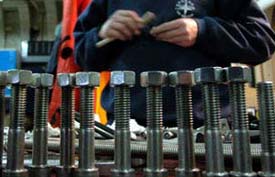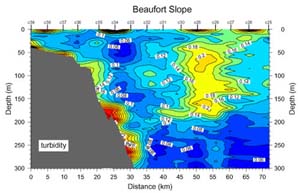|
|
 |
Daily Update
Calendar
Dispatch 25 - August 8, 2002
By C.A. Linder
Weather conditions: intermittent drizzle, overcast skies, winds 10 knots from the NE, 1 ft. seas, air temperature 41° F.
Ice Free
We have left the ice behind us; open water lies ahead. This morning, we felt only a few rumbles as the Polar Star’s massive bow pushed vagrant ice floes aside. One last polar bear bid us farewell, leaping from the ice into the freezing water and swimming vigorously away from the odd-sounding red and white intruder. We are now making 15 knots (roughly 17 mph) through the open water, and after the 4-5 knots we had gotten used to in the ice, we feel like we’re flying.
We continued to stow science gear today, making sure everything was tied down securely. Even one moderate roll of the ship can hurl fragile computers onto the decks. The ship’s Marine Science Technicians also took apart the ship’s trusty CTD frame piece by piece, giving it a thorough cleaning and storing it safely away. It took the better part of a day, since the frame is so sturdily constructed. Everyone is silently hoping that the seas remain as calm as they have been so far, but we have prepared for the worst.
 |
 |
|
Marine Science Technician Lee Brittle carefully cleans every bolt from the CTD.
|
|
Click to enlarge |
Our data processing also continued, and we discovered another very interesting result in the Beaufort slope CTD data. For a discussion of the temperature of the water along this cross-section, please read Dispatch 22. We previously noticed a lens-shaped blob of colder water in the slope waters between stations c27 and c30, which we are speculating has somehow traveled from the shelf to the slope. To assist us in our sleuthing, we decided to look at a different type of data the CTD has collected - water turbidity. This is essentially the “clarity” of the water - how clear is it, or how dirty?
 |
 |
|
Turbidity section across the Beaufort slope, showing a “lens” of sediment-laden water. |
|
Click to enlarge |
On the section at right, turbid waters are shown in bright colors, and clearer waters are blue/purple. To our great delight, a similar lens-shaped structure is also clearly evident in the turbidity data (the yellow-colored blob between c27 and c30 in the plot). This data appears to reinforce our opinion that the lens has come from the shelf... Sediment - small mud and sand particles, can be stirred up and carried away by vigorous mixing along the shelf. The fact that this area of high "muddiness" corresponds to the blob of colder water we saw in the temperature data seems to indicate that the blob has come from the shelf, carrying with it muddy bits of the sediment and the colder temperatures you can expect to find in nearshore waters. It is particularly amazing to see such a positive correlation so early in our data analysis, and it has whet our appetites for the mooring data... It’s going to be a long 13 months of waiting and hoping!
 Previous Dispatch
Next Dispatch Previous Dispatch
Next Dispatch

Back to Calendar
|
|




